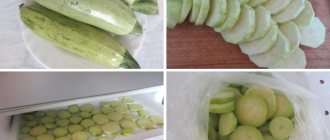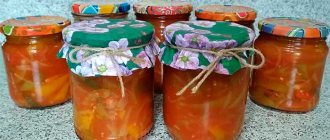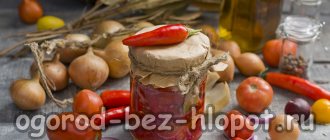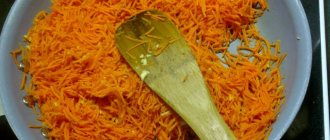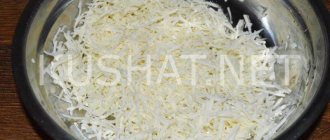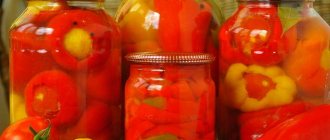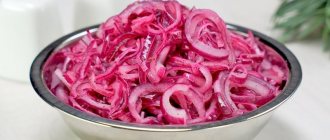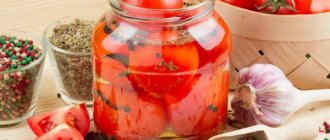With halfway through summer, the hot time comes for housewives - the season of harvesting everything that has grown so generously in our summer cottages.
One of the many types of harvest preservation that I personally use is freezing vegetables and fruits.
Many may find disadvantages to this method: for example, frozen cucumbers, zucchini or tomatoes turn into a porridge-like puree after defrosting, but this is only if they are not frozen correctly...
That is why I decided to share the secrets of freezing with young housewives, because there are nuances in any business and this is no exception. I have already told similar subtleties, but they related to making jam.
Basic rules for freezing vegetables and fruits
- You can freeze whatever your heart desires. The only thing I make an exception for is onions and garlic. In the process of freezing these vegetables, all their beneficial qualities and phytoncidal effect are lost. But these products can be stored for the whole winter anyway.
- If the electricity suddenly goes out, there is no need to panic and go into the freezer. Without our participation, frozen fruits and vegetables will be safe for another 5-6 hours.
- To serve frozen berries or fruits in their natural form on the table (for example, as a dessert), do not defrost them using emergency methods (no need to heat them) - this will cause them to lose their taste and appearance. They need to be defrosted for an hour at room temperature, after removing them from the freezer.
- If you need to cook frozen fruit compote or frozen mushroom soup, you do not need to defrost them, but immediately remove a portion from the freezer and put them in boiling water.
- Frozen greens should be added to first courses when they are ready and the stove is turned off.
- Only fresh and ripe vegetables and fruits should be frozen. Overripe ones will fall apart into a puree when defrosted.
- It is advisable to freeze products in portions designed for one cooking.
How to properly cook frozen vegetables
Vegetable preparations are suitable for people who value their time, as well as for adherents of proper nutrition. Frozen vegetables are tasty and healthy in any form. There are many recipes with assorted vegetables. It should be noted that most do not even defrost the product before cooking, although this is wrong, because vegetables lose their beneficial properties.
Before starting preparation, the mixture must be defrosted, rinsed and dried (allow excess moisture to drain). Now you can start frying or stewing. Remember, do not cook vegetables for too long, as this destroys vitamins. Store-bought assorted vegetables usually take no more than 15-20 minutes to prepare. If you freeze vegetables yourself, make sure they have the optimal combination. After all, too large slices of cabbage, broccoli or other vegetables will take longer to cook than zucchini, pumpkin or carrot cubes. Therefore, they should be cut quite finely.
Freezing greens
Wash and dry the herbs and sprigs of herbs, spreading them on a clean towel. Then cut it into 1 cm pieces and place it tightly in the prepared packaging - bags or molds. If you are not using special bags (with a zipper), then tie the bags not with a knot, but with a loop, which will then allow you to easily untie it.
It is advisable to sign the greens with a marker. After all, frozen greens can be confused (for example, parsley with cilantro or celery).
Freezing ice with herbs and fruits
You can also prepare spiced ice for future use. To do this, put herbs in molds for freezing ice and add a small amount of boiled water. When the contents of the mold are frozen, remove the cubes from the mold and put them in a bag.
Preparing greens this way takes more time, and there is more storage space in the freezer.
Another chic feature can be fruits and flowers frozen in ice, which can then be thrown into a cocktail. To do this, take the most beautiful raspberries or strawberries (possibly with sepals), violets or pansies and freeze them in a silicone mold with fruit syrup or plain boiled water.
Fried vegetables
You can very quickly prepare a vegetable side dish from asparagus, cauliflower, peppers and peas. Frozen vegetables should be fried in a frying pan for 15-20 minutes until golden brown. At the end of frying, add a clove of garlic (chopped or whole), as well as ketchup or 1 tablespoon of tomato paste. Sprinkle everything generously with herbs; green onions and basil would be useful in this dish.
Many people are interested in how to cook frozen vegetables along with potatoes in a frying pan, because the cooking time for these dishes is different. The thing is that natural vegetable juice will not allow the potatoes to fry until golden brown. Therefore, if you want fried potatoes and fried vegetables, then you should cook them separately. An excellent option would be chopped jacket potatoes (pre-cooked) along with vegetables in a regular frying pan or on the grill. To do this, take 3-4 medium potatoes and boil them in their skins. Then cut into slices or circles with a diameter of at least 1 cm. Sprinkle the chopped potatoes with spices (paprika, salt, herbs de Provence). In a preheated frying pan, fry the vegetable mixture until golden brown, then add the potatoes to it. The dish is ready.
How to freeze vegetables
Frozen green peas
A prerequisite for freezing green peas is their milky ripeness. The peas should be removed from the pods, packed in plastic bags and placed in the freezer.
If you freeze peas in bulk and then pack them, the peas will not freeze, which makes them convenient to use.
Frozen green beans
The pods of asparagus beans must be peeled from the tails and cut into pieces.
The prepared pieces should be blanched in salted boiling water for 2-3 minutes and drained in a colander. If this is not done, the beans will turn out fibrous and not tasty.
Pack the dried pieces and place them in the freezer.
Frozen sweet peppers
The most beautiful pepper must be washed, cleaned of seeds and stalks. Dry. You can cut them into 4 pieces into strips and put them in a bag - this will be an addition to side dishes, soups, and stews.
Or you can fold a whole pepper into a nesting doll one on one - this will be a preparation for stuffing peppers. And if you have minced meat on hand and a little time, we stuff the peppers and also put them in the freezer, but this is a ready-made semi-finished product.
Pepper seeds can also be used: wash and dry. Dry pepper seeds can be ground in a coffee grinder and an excellent natural seasoning is ready. It will come in very handy when you get ready to cook Adjarian khachapuri.
Frozen Cauliflower
Cauliflower, disassembled into inflorescences, must be blanched for 2-3 minutes in boiling salted water. Dry, pack and store in the freezer.
This cabbage is always a hit in winter soup or stew. And especially for stews, I practice freezing the whole set in portioned bags: cauliflower, carrot pieces, peas, leeks.
Frozen tomatoes, zucchini and cucumbers
Although I wrote that freezing these vegetables is not very popular, I still do it, albeit with some little tricks and secrets.
Tomatoes
Don’t rush to throw away cracked or spoiled tomatoes—they can also be frozen. To do this, peel them, cut them into slices, place them on a tray in one layer and freeze them. Then we pack the frozen vegetables into portioned bags and use them in the winter to make pizza, borscht dressing, and pasta sauce.
cucumbers
You can freeze a cucumber, but you can only use it for one purpose - making winter okroshka.
Attention! If you defrost cucumbers in a separate container, you will end up with cucumber pulp, which you will have to throw away. In order to get beautiful defrosted vegetables, place a portion of frozen cucumbers to defrost directly into the prepared okroshka.
Zucchini
Zucchini can also be frozen to make a stew. One secret to freezing: grate the zucchini on a medium beet grater and squeeze out the juice, which they will release after a while.
How to freeze vegetables for the winter
A century ago, people were forced to eat only seasonal foods, but since refrigerators and freezers appeared in our homes, the diet can be varied all year round. Not only that, research shows that in winter and early spring, vegetables and fruits from the freezer are healthier than those you see on store shelves. Of course, in order for frozen foods to remain healthy, you need to take into account some nuances in addition to the fact that they must be initially fresh. And I will focus on them now.
The first nuance is to pay attention to packaging. Those bags in which you usually bring food from the supermarket are not suitable for freezing (except for a short period of time). It is best to freeze in special containers or tight bags designed for this purpose that will not break. You can even freeze broth or soup in a bag if you place the bag of soup in a hard container and remove it after the liquid has frozen. After placing the product in the bag, do not forget to squeeze out the air from there and close it tightly; for this you will need special clamps or special adhesive tape. In this case, liquid products should be left with a small margin for expansion. You can also use foil, but it must be thick (thin foil often breaks). When choosing containers for freezing prepared meals, use ones that can be immediately placed in the oven or microwave. Everything placed in the freezer should be labeled - mark what kind of product it is and set the date of freezing. This can be done using a marker (write directly on the packaging) or adhesive labels. Don’t think that you can easily remember everything anyway, because foods change their appearance after freezing, and over time you forget what exactly is in the freezer. I have a separate page in my diary for this purpose, where I note what is in each freezer compartment. Remember also that putting too much fresh food into the freezer is harmful to the food that is already there, so make sure that no more than 1 kg of fresh food gets into your freezer for every 8 liters of freezer per day.
The second nuance is to take into account which foods should be frozen and which are undesirable.
Vegetables. Fresh vegetables are peeled, washed, chopped and frozen in portions, often after blanching (immersing them in boiling water for a few minutes). This process affects the natural enzymes that are present in vegetables and, when frozen, can change their taste, color and quality. Beets should be frozen boiled and grated; in winter you can make a salad or borscht with them. Carrots and pumpkin can be frozen raw, boiled, grated, or cut into cubes - depending on the dishes in which you want to use them. Peppers are cut into pieces and frozen raw or after blanching. You can also freeze tomatoes, but keep in mind that they should only be used in cooking, as they lose their elasticity. For example, I freeze tomatoes cut into slices (for pizza), quarters (for vegetable dishes) and whole (if you put such a tomato under hot water, it peels off perfectly). Celery and onions also become soft after freezing, but this does not prevent them from being used in cooking. Eggplants should also be blanched before freezing. Remember that vegetables that contain a lot of water (cucumbers, lettuce, radishes) are not suitable for freezing fresh, but you can freeze them as a puree.
Fruits. Apples, pears and peaches should be sprinkled with lemon juice when frozen. Freeze apricots and plums in pitted halves, but do not let them defrost before cooking; throw them into compote or place them frozen on the dough. Bananas, melons, and citrus fruits should not be frozen (you can freeze the zest and juice). Apricots, prunes, grapes are ideal for making dried fruits.
Berries. They can be frozen in bulk, and then poured into a bag, or they can be immediately poured into containers (when they are well frozen, they will be separated from each other using a knife). Some people like to freeze berries with sugar or powdered sugar. Strawberries become soft after defrosting, so it’s worth making puree from them (it’s very convenient to fill ice cube trays with puree, and in winter take as many “strawberry cubes” as you want). You can remove the pits from the cherries, or you can leave them with the pits.
Herbs. Fresh, washed greens can be placed in the freezer whole, chopped and placed in a container, or placed in ice cube trays and filled with water. You can also prepare greens by drying them.
Seeds and nuts. They are well preserved when frozen, and it is convenient to grate the nuts immediately and then use them in various dishes and baked goods.
Pasta, rice and potatoes. These products are tastier fresh, but sometimes you have to freeze them too. Remember that boiled potatoes in pieces will not be edible after being in the freezer. If you need to freeze cooked potatoes, mash them. Rice and pasta change their taste when frozen, so it's up to you whether you want to freeze them.
Beverages. Juices and wine can be poured into an ice tray and then used in cooking.
The third important nuance is to learn the rules of defrosting. Unlike freezing, the reverse process must be slow and is best done in the refrigerator. You can leave it frozen on the kitchen counter (this will speed up the process), but do not remove the product from the package. Many people use a microwave oven for defrosting, but you should be very careful here, since there is a risk of overcooking the product and its defrosting will turn into cooking (so set it to the lowest power setting).
Frozen berries and fruits with sugar
Raspberries, strawberries, blackberries, currants, and gooseberries are suitable for this method of freezing fruit.
- We wash the berries, dry them and mash them in a mortar or grind them in a blender.
- Mix the berry puree with sugar until it is completely dissolved.
Sugar should be added to taste, but not more than 500 grams per 1 kilogram of berries.
We put the resulting mass into plastic containers and put it in the freezer. You can make puree from one type of berries, or from a mixture of them, it all depends on your taste and how you will use the frozen berries (to make compote, jelly, yogurt or other dessert).
Frozen watermelon
Frozen pink ice cubes made from watermelon puree will surprise the most experienced housewives in winter. The watermelon can be cut arbitrarily, cut out with cookie cutters, or made into beautiful balls with an ice cream spoon.
In winter, we throw a watermelon cube into a cocktail or a glass of champagne and we are guaranteed summer memories!
Frozen melon
You can freeze melon, but you need to remember its slightly specific taste - frozen melon is a little bitter. But still, if you have a tasty melon, try freezing it. Just like watermelon, cut the melon pulp into cubes and freeze.
But try using it in alcoholic cocktails - the alcohol will mask the bitterness of the melon, but the aroma will be unique.
As you can see, freezing fruits and vegetables in a home refrigerator is not at all difficult, you just have to remember the small nuances of freezing each product. I wish you a generous harvest in your garden beds and unique dishes and drinks in the winter when you start using freezing from the refrigerator!
Step-by-step preparation
- We wash all the vegetables.
- Cut the pepper into large strips.
- Cut the onion into half rings.
- Coarsely chop the greens.
- Cut the garlic in half lengthwise.
- Cut the hot pepper into slices.
- Cut off the tails of the cucumbers. Soak the cucumbers in water for several hours.
- Prick the tomatoes with a fork to prevent them from bursting.
- We wash the jars with soda or sterilize them. The jars must be dry. Place parsley, peppercorns, hot peppers and cloves on the bottom of the jar. Also add garlic, onion, pepper.
- Cut the cucumbers into pieces.
- Place a layer of cucumbers in a jar and lightly compact the vegetables.
- Place tomatoes on top.
- Fill the lids with boiling water and leave for 5-7 minutes.
- Fill the jars with boiling water until the end.
- Cover with lids. Leave for 10 minutes.
- Drain the water into the pan. We make a marinade from this water.
- To do this, add salt and sugar. Place on the fire and bring to a boil.
- Cook for a couple of minutes until the sugar and salt are completely dissolved. Remove from heat and pour in vinegar.
- Pour the hot marinade over the vegetables to the very top.
- We roll up the jars, wrap them and turn them over. Let the jars cool completely. Ready!
Variations in cooking
Such assorted vegetables are a real salvation in winter. There are not many vegetables in winter, they are expensive and not always tasty, and the human body requires vitamins. This assortment will provide a maximum of vitamins and saturate the body with useful substances. And it's also very tasty! You can add whatever ingredients you want to the jar. This particular assortment will be spicy due to the pepper in the composition. You can omit it if you don't like it spicy. If you want these jars to last all winter, store them in a cool place. Such recipes will appeal to those who love vegetables and really miss them in the winter. Vegetables in jars can be safely served at the holiday table or eaten for lunch or dinner. Vegetables will be ideally combined with meat, fish and other dishes. It will be especially tasty if you make puree, fry the meat and serve this assorted vegetable dish to the table.
